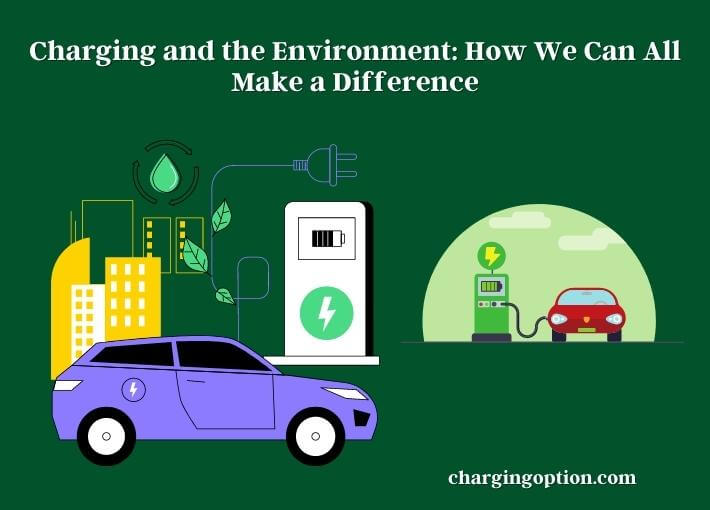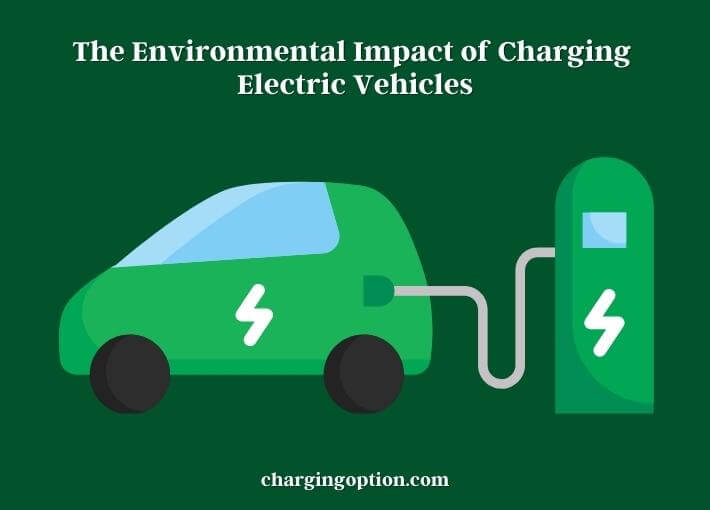Published on: April 21, 2024
Written by Rizbi Neyaj / Fact-checked by Ozzy Evander
Electric vehicles (EVs) are becoming more popular as consumers and governments seek alternatives to traditional gasoline-powered vehicles. As climate change and air pollution become more pressing concerns, the transition to EVs offers many benefits, such as reduced emissions and lower operating costs. Charging these vehicles can have a significant impact on the environment.

One of the key advantages of EVs is their ability to reduce greenhouse gas emissions, which contribute to climate change. According to the International Energy Agency (IEA), transportation is responsible for approximately 24% of global CO2 emissions, with road transport accounting for the majority of those emissions. EVs offer a promising solution to reducing these emissions, as they produce significantly fewer greenhouse gases compared to traditional gasoline-powered vehicles.
The environmental impact of charging EVs should not be overlooked. Generating the electricity needed to charge EVs can have a significant carbon footprint. According to the Union of Concerned Scientists, the carbon emissions associated with charging an EV vary widely depending on the source of the electricity.
Charging an EV with electricity from renewable sources such as wind or solar power results in significantly lower carbon emissions compared to electricity generated from fossil fuels. The production of batteries for EVs can also result in significant emissions. The mining of raw materials such as lithium and cobalt, the manufacturing process, and the transportation of batteries all contribute to the emissions associated with EVs. Furthermore, battery disposal presents environmental concerns as it can contain toxic chemicals.
Charging
Charging refers to the process of supplying electric energy to a device or battery, typically using a charger or power source. This process involves transferring electric charge into the device or battery, which can then be used to power it. Charging is a crucial aspect of using electronic devices, as it allows them to operate without relying solely on internal power sources like batteries or capacitors.
The Environmental Impact of Charging Electric Vehicles
Generating the electricity needed to charge EVs can have a significant impact on the environment. The carbon emissions associated with charging an EV vary widely depending on the source of the electricity. According to the Union of Concerned Scientists, charging an EV with electricity from renewable sources such as wind or solar power results in significantly lower carbon emissions compared to electricity generated from fossil fuels.
In countries where the electricity grid relies heavily on coal or natural gas, charging EVs can result in emissions similar to or higher than those of gasoline-powered vehicles. However, in countries with a cleaner electricity grid, such as Norway or Sweden, charging EVs can result in significantly lower emissions.
The production of batteries for EVs can also result in significant emissions. The mining of raw materials such as lithium and cobalt, the manufacturing process, and the transportation of batteries all contribute to the emissions associated with EVs. Furthermore, battery disposal presents environmental concerns as it can contain toxic chemicals.

To reduce the emissions associated with battery production, some manufacturers are exploring more sustainable alternatives. For example, Tesla (some EV owners may wonder if they can charge their Rivian with a Tesla charger) is developing a lithium-ion battery that uses less cobalt, which is a scarce and expensive resource. Other companies are exploring the use of solid-state batteries, which do not contain the same toxic chemicals as traditional lithium-ion batteries.
Another strategy to reduce the environmental impact of charging EVs is the development of renewable energy sources. Increasing the use of wind and solar power can reduce the carbon footprint of electricity generation.
Smart charging and demand response can also play a role in reducing emissions. Smart charging involves charging EVs during off-peak hours when there is excess renewable energy available. Demand response involves adjusting the charging rate based on the grid’s needs.
The environmental impact of charging electric vehicles is dependent on the source of the electricity used. Charging EVs with renewable energy sources such as wind or solar power can significantly reduce emissions compared to traditional fossil fuels. Developing more sustainable alternatives to battery production and exploring strategies such as smart charging and demand response can further reduce the carbon footprint of EVs.
If you want to know about understanding charging and power management. Click here for this.
Strategies to Reduce the Environmental Impact of Charging
As the adoption of electric vehicles (EVs) continues to increase, it is important to consider strategies to reduce the environmental impact of charging these vehicles. Here are some strategies that can help:
Increase the Use of Renewable Energy Sources
The use of renewable energy sources such as wind and solar power can significantly reduce the carbon footprint of electricity generation. Governments and utilities can incentivize the development of renewable energy sources and increase their use in the electricity grid to support the charging of EVs.
Smart Charging
Smart charging involves charging EVs during off-peak hours when there is excess renewable energy available. This can help reduce the load on the grid during peak hours and increase the use of renewable energy sources.
Demand Response
Demand response involves adjusting the charging rate based on the grid’s needs. This can help utilities balance the supply and demand of electricity and reduce the need for fossil fuel-powered peaker plants during peak hours.
Battery Recycling
Recycling used batteries can reduce the need for new battery production and reduce the environmental impact of battery disposal. Some companies are exploring the use of recycled materials in new batteries.
Sustainable Battery Production
Some manufacturers are exploring more sustainable alternatives to battery production. For example, Tesla is developing a lithium-ion battery that uses less cobalt, which is a scarce and expensive resource. Other companies are exploring the use of solid-state batteries, which do not contain the same toxic chemicals as traditional lithium-ion batteries.
Energy-Efficient Charging Infrastructure
The charging infrastructure can also be designed to be more energy-efficient. For example, using energy-efficient chargers and optimizing the location of charging stations to reduce the need for long-distance travel.
Public Education and Awareness
Public education and awareness campaigns can help encourage consumers to adopt sustainable charging practices such as using renewable energy sources and smart charging.
The Role of Governments and Corporations
Governments and corporations play a critical role in promoting sustainable charging practices for electric vehicles (EVs). Here are some ways they can contribute to reducing the environmental impact of charging EVs:
Government Incentives
Governments can provide incentives for the development of renewable energy sources, the installation of charging infrastructure, and the purchase of EVs. Incentives such as tax credits, rebates, and subsidies can help increase the adoption of EVs and promote sustainable charging practices.
Regulations
Governments can also regulate the production and disposal of batteries and encourage sustainable practices in the manufacturing and disposal of batteries. For example, regulations can be put in place to ensure that batteries are recycled and not discarded in landfills.
Investment in Charging Infrastructure
Governments and corporations can invest in the development of charging infrastructure, particularly in areas where charging infrastructure is lacking. This can help increase the accessibility and convenience of charging for EV owners.
Corporate Sustainability Initiatives
Corporations can take steps to reduce the environmental impact of their operations, including the charging of EVs. For example, corporations can switch to renewable energy sources, invest in charging infrastructure and promote sustainable charging practices among their employees.
Research and Development
Governments and corporations can invest in research and development to improve the efficiency and sustainability of charging technology. This can include the development of more efficient batteries, charging infrastructure, and energy management systems.
Public Education and Awareness
Governments and corporations can also promote public education and awareness campaigns to encourage sustainable charging practices among consumers. This can include providing information on the environmental impact of charging EVs and the benefits of using renewable energy sources and smart charging.
Governments and corporations have an important role to play in promoting sustainable charging practices for electric vehicles.
The Future of Electric Vehicle Charging and the Environment
As the demand for electric vehicles (EVs) continues to grow, the future of EV charging is becoming increasingly important for the environment. Here are some potential developments and trends that could shape the future of EV charging and its impact on the environment:
Increased use of renewable energy: The adoption of renewable energy sources is likely to continue to increase in the coming years, which will significantly reduce the carbon footprint of EV charging. This will be supported by the development of smart grids, which will enable more efficient use of renewable energy sources.
Growth of wireless charging: Wireless charging technology is currently being developed, which would enable EVs to charge wirelessly while parked. This could reduce the environmental impact of EV charging by eliminating the need for physical charging infrastructure.
Increased use of fast charging: Fast charging technology is also being developed, which could significantly reduce the charging time for EVs. This could encourage more people to switch to EVs, which would ultimately reduce the environmental impact of transportation.
Integration with energy storage systems: EV charging infrastructure could be integrated with energy storage systems, such as batteries or capacitors. This could enable the storage of excess renewable energy during off-peak hours and the use of that energy for charging EVs during peak hours.
Development of more sustainable batteries: Manufacturers are exploring the use of more sustainable materials in battery production, such as solid-state batteries or batteries that use less cobalt. This could reduce the environmental impact of battery production and disposal.
Continued investment in charging infrastructure: Governments and corporations are investing heavily in the development of EV charging infrastructure, which will be essential for the widespread adoption of EVs. The use of sustainable materials and renewable energy sources in the construction of charging infrastructure will be critical for reducing the environmental impact of charging.
Public education and awareness: Public education and awareness campaigns will continue to play a critical role in promoting sustainable charging practices. The importance of using renewable energy sources, smart charging, and battery recycling will continue to be emphasized.
The future of EV charging holds great potential for reducing the environmental impact of transportation. The integration of renewable energy sources, wireless charging, fast charging, and energy storage systems, as well as the development of more sustainable batteries, will all play important roles in shaping the future of EV charging.
The continued investment in charging infrastructure and public education and awareness will also be critical for promoting sustainable charging practices and achieving a more sustainable transportation system.
Final Thought
As the world transitions to more sustainable transportation systems, the environmental impact of electric vehicle charging must be taken into consideration. Sustainable charging practices, such as the use of renewable energy sources and smart charging technology, can significantly reduce the carbon footprint of EV charging.
Governments and corporations have an important role to play in promoting sustainable charging practices. Through incentives, regulations, investment in charging infrastructure and research, and development, they can help reduce the environmental impact of charging EVs.
The future of EV charging holds great promise for reducing the environmental impact of transportation. Continued investment in sustainable charging infrastructure, the integration of renewable energy sources, wireless and fast charging technology, and the development of more sustainable batteries will all play important roles in achieving a more sustainable transportation system.

